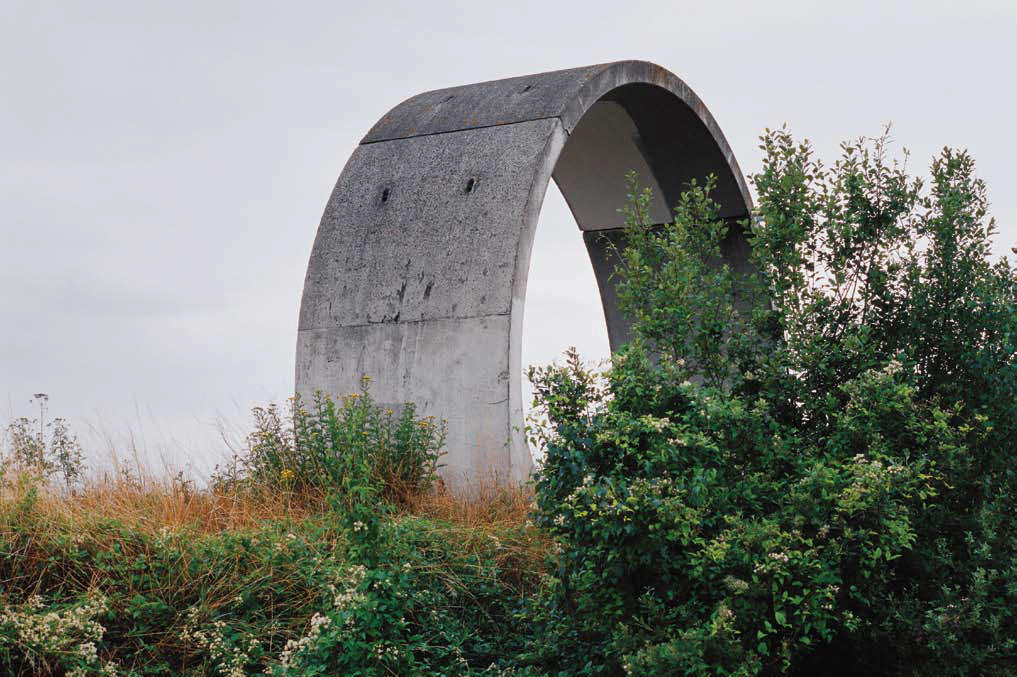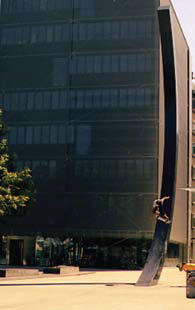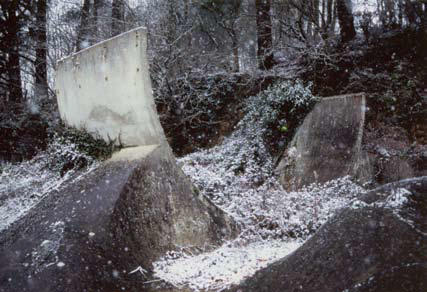
Raphaël Zarka collects sculptural forms. His ongoing series, Les Formes du Repos (Resting Forms), begun in 2001, consists of photographs of remnants of human enterprise littering the landscape: a stretch of unfinished monorail, a concrete breakwater, a lone pylon.
Zarka captures the sculptural possibilities of these forms as images, such that the abandoned, the disused, and the forgotten become sites of potential, with a lexicon of formal associations that runs from Plato to modernism to postminimalist sculpture. Moving beyond the strategies associated with archives and appropriation, which have come to characterize contemporary art production in recent years, Zarka’s project reinvests cultural remnants of the past with both functional and aesthetic promise.
Zarka sees himself as an essayist, as well as an artist and collector. Robert Smithson is one of his heroes, less for the formal manifestations of his work than for his writing and his mining of an eclectic range of cultural production. The critic Hal Foster observed, in his text on “the archival impulse,” that the retrieval of preexisting sources, be they photographic, filmic, or textual, is carried out by artists “in a gesture of alternative knowledge.” This observation is echoed to a certain extent in a statement by Zarka: “I never try to present reality as it is. On the contrary, I’m stressing the fact that we can only ever see the world from our own particular cultural viewpoint.”
Zarka’s most recent series, Riding Modern Art extends his investigations of the sculptural as image further, combining the “found forms” of public sculpture with “found images” that make up part of the subcultural vernacular of the urban skateboarder. Zarka began collecting photographs of skaters and sculptures from skateboarding magazines after making a short video in which he montaged his own footage of skateboarders riding sculptures in public spaces. The choice of subject matter wasn’t random. Zarka, who lives in Paris, is a skater himself and has become something of a legend in skateboarding circles since the 2006 publication of his book Chronologie lacunaire du skateboard, 1779–2005: Une journée sans vague (An Incomplete Chronology of Skateboarding, 1779–2005: A Day Without a Wave).

Riding Modern Art was presented by Zarka at the 2007 Lyon Biennale in response to an invitation by the artist Pierre Joseph. Zarka riffed on Joseph’s concept of personnages à réactiver (people to reactivate), applying it to a particular history of sculpture evidenced in corporate plazas and commercial precincts in cities across Europe. He presented eleven framed photographs on two adjoining walls. The third element of the installation was Spatial Composition 3, a monochrome sculpture constructed of curves and right angles made by avant-garde Polish artist Katarzyna Kobro in 1928, which epitomizes what Zarka describes as “the forms of modernity.”
While the borrowed sculpture by Kobro and the framed photographs are, in essence, readymades, in Zarka’s staging of them they’re endowed with a particular momentum in terms of visual and conceptual impact. The suspension of action in images of skateboarders executing gravity-defying wall rides, backside kick flips, and caveman drop-ins and the faded grandeur of monumental modernist sculptures from the 60s result in an attention-grabbing collision of cultural aspirations past and the adrenaline rush of high-velocity physical activity.
Like Les Formes du Repos, Zarka’s Riding Modern Art proposes liberation from history and/or cultural memory as an arrested state. Zarka’s images refer us to a more democratic potential within form, encapsulated in the approach of the skateboarders, for whom every surface and every curve is a potential ride. Zarka’s approach could be considered in terms of the “open form,” a concept developed by the influential Polish architect, designer, and teacher Oscar Hansen in the 1950s, with a view to integrating spatial forms and their surroundings so as to create backgrounds for events that involve the viewer. (The artist Pawel Althamer, a graduate of the studio of Grzegorz Kowalski at the Warsaw Academy of Fine Arts, is considered one of the more prominent contemporary exponents of Hansen’s theory.)
In his visual ecology of reinvestment and reuse, Zarka not only creates a space of physical and temporal layering with assured elegance but propels us into dimensions of discovery and, for those of us used to considering our art from a position of polite critical scrutiny, some vicarious thrill-seeking. Old terrain, left for dead, suddenly becomes new again.
